 Alpha_h4ck
Alpha_h4ck- 关注
0
1
2
3
4
5
6
7
8
9
0
1
2
3
4
5
6
7
8
9
0
1
2
3
4
5
6
7
8
9
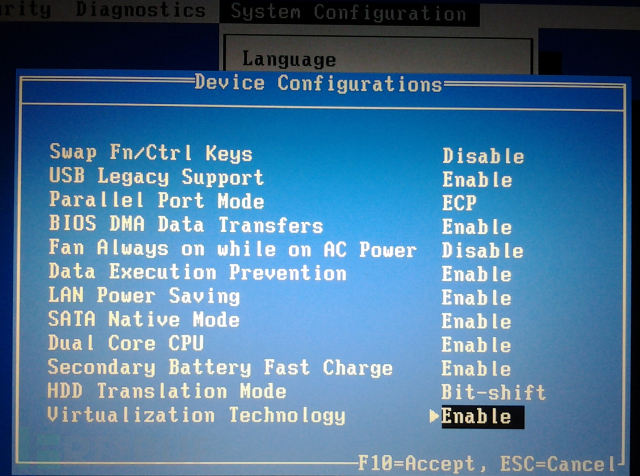
写在前面的话
如果我有一台基于云的虚拟机,并且运行了Ubuntu或CentOS的Linux服务器系统,而这些设备可能是虚拟化的,也可能不是虚拟化的,那我们应该如何去判断这台Linux Guest系统设备使用的是哪种虚拟化技术(VMWARE/ KVM/ XEN/ VirtualBox/ Container/lxc/Hyper-V等等)呢?那我们如何才能识别一台CentOS 7 Linux VPS所使用的虚拟化技术类型呢?
技术分析
我们需要使用virt-what程序(一个Shell脚本)来检测目标设备系统所使用的虚拟化技术类型,它可以打印出每一条关于目标设备虚拟化技术的相关信息。在这篇文章中,我们将介绍如何去判断Linux Guest VM虚拟化技术类型。
判断Linux Guest VM虚拟化技术类型
正如我们刚才说的,我们需要使用virt-what Linux命令来判断一个程序当前是否在一台虚拟机设备上运行。该脚本支持各种虚拟机管理程序,接下来,我们看看如何在不同的Linux发行版系统中安装virt-what。
Debian或Ubuntu Linux安装
首先,运行下列apt命令/apt-get命令:
$ sudo apt-get install virt-what或者
$ sudo apt install virt-what 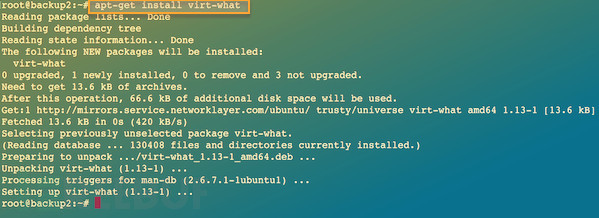
在RHEL/CentOS/Scientific Linux VM中安装virt-what
我们可以使用yum命令完成安装:
$ sudo yum install virt-what 
Fedora Linux VM安装virt-what来检测当前环境是否为虚拟机环境
执行dnf命令:
$ sudo dnf install virt-whatSuse/OpenSUSE安装
运行zypper命令:
sudo zypper in virt-what 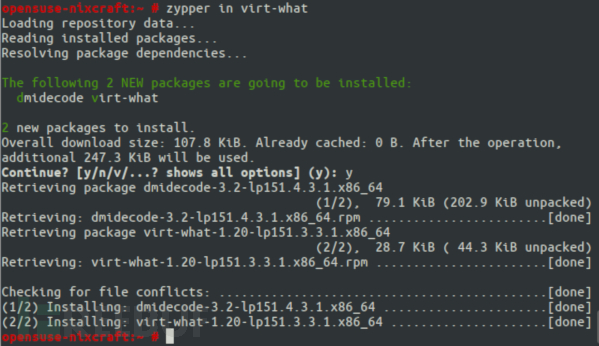
判断远程服务器是否为虚拟机环境
我们可以直接输入并运行下列命令:
$ $ sudo virt-what
xen
xen-domU
输出结果:
$ $ sudo virt-what
kvm
其他输出结果:
$ $ sudo virt-what
lxc
下面给出的是AWS返回的结果:
$ sudo virt-what
xen
xen-hvm
aws
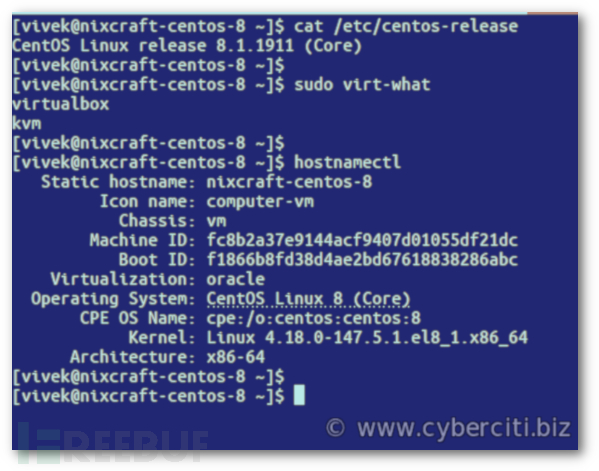
其他可能的值
1、hyperv : 这是微软的Hyper-V管理程序;
2、parallels : 访客用户正在Parallels虚拟平台(Parallels Desktop、Parallels Server)中运行;
3、powervm_lx86 : 访客用户正在IBM powervm lx86 Linux/x86模拟器中运行;
4、qemu : 这是使用软件模拟技术的QEMU管理程序;
5、virtualpc : 访客用户正在微软VirualPC上运行;
6、xen-hvm : 这是一个Xen Guest完全虚拟化平台(HVM);
7、uml : 这是一个用户模式Linux(UML)客户机;
8、openvz : 访客用户正在OpenVZ或Virtuozzo容器中运行;
9、linux_vserver : 此进程正在Linux VServer容器中运行;
10、ibm_systemz : 这是一个IBM SystemZ硬件分区系统;
如果没有任何输出结果,那意味着我们的程序可能是在裸机上运行的,或者程序是在一种我们无法检测到的虚拟机系统中运行的。
检测脚本源代码
下面给出的是脚本的源代码:
#!/bin/sh -
# virt-what. Generated from virt-what.in by configure.
# Copyright (C) 2008-2017 Red Hat Inc.
#
# This program is free software; you can redistribute it and/or modify
# it under the terms of the GNU General Public License as published by
# the Free Software Foundation; either version 2 of the License, or
# (at your option) any later version.
#
# This program is distributed in the hope that it will be useful,
# but WITHOUT ANY WARRANTY; without even the implied warranty of
# MERCHANTABILITY or FITNESS FOR A PARTICULAR PURPOSE. See the
# GNU General Public License for more details.
#
# You should have received a copy of the GNU General Public License
# along with this program; if not, write to the Free Software
# Foundation, Inc., 675 Mass Ave, Cambridge, MA 02139, USA.
# 'virt-what' tries to detect the type of virtualization being
# used (or none at all if we're running on bare-metal). It prints
# out one or more lines each being a 'fact' about the virtualization.
#
# Please see also the manual page virt-what(1).
# This script should be run as root.
#
# The following resources were useful in writing this script:
# . http://dmo.ca/blog/detecting-virtualization-on-linux/
# Do not allow unset variables, and set defaults.
set -u
root=''
skip_qemu_kvm=false
skip_lkvm=false
VERSION="1.20"
have_cpuinfo () {
test -e "${root}/proc/cpuinfo"
}
use_sysctl() {
# Lacking /proc, on some systems sysctl can be used instead.
OS=$(uname) || fail "failed to get operating system name"
[ "$OS" = "OpenBSD" ]
}
fail () {
echo "virt-what: $1" >&2
exit 1
}
usage () {
echo "virt-what [options]"
echo "Options:"
echo " --help Display this help"
echo " --version Display version and exit"
exit 0
}
# Handle the command line arguments, if any.
while test $# -gt 0; do
case "$1" in
--help) usage ;;
--test-root=*)
# Deliberately undocumented: used for 'make check'.
root=$(echo "$1" | sed 's/.*=//')
shift 1
test -z "$root" && fail "--test-root option requires a value"
;;
-v|--version) echo "$VERSION"; exit 0 ;;
--) shift; break ;;
*) fail "unrecognized option '$1'";;
esac
done
test $# -gt 0 && fail "extra operand '$1'"
# Add /sbin and /usr/sbin to the path so we can find system
# binaries like dmidecode.
# Add /usr/libexec to the path so we can find the helper binary.
prefix=/usr/local
exec_prefix=${prefix}
PATH="${root}${exec_prefix}/libexec:${root}/sbin:${root}/usr/sbin:${PATH}"
export PATH
# Check we're running as root.
EFFUID=$(id -u) || fail "failed to get current user id"
if [ "x$root" = "x" ] && [ "$EFFUID" -ne 0 ]; then
fail "this script must be run as root"
fi
# Try to locate the CPU-ID helper program
CPUID_HELPER=$(which virt-what-cpuid-helper 2>/dev/null)
if [ -z "$CPUID_HELPER" ] ; then
fail "virt-what-cpuid-helper program not found in \$PATH"
fi
# Many fullvirt hypervisors give an indication through CPUID. Use the
# helper program to get this information.
cpuid=$(virt-what-cpuid-helper)
# Check for various products in the BIOS information.
# Note that dmidecode doesn't exist on all architectures. On the ones
# it does not, then this will return an error, which is ignored (error
# message redirected into the $dmi variable).
dmi=$(LANG=C dmidecode 2>&1)
# Architecture.
# Note for the purpose of testing, we only call uname with -m option.
arch=$(uname -m | sed -e 's/i.86/i386/' | sed -e 's/arm.*/arm/')
# Check for VMware.
# cpuid check added by Chetan Loke.
if [ "$cpuid" = "VMwareVMware" ]; then
echo vmware
elif echo "$dmi" | grep -q 'Manufacturer: VMware'; then
echo vmware
fi
# Check for Hyper-V.
if [ "$cpuid" = "Microsoft Hv" ]; then
echo hyperv
fi
# Check for VirtualPC.
# The negative check for cpuid is to distinguish this from Hyper-V
# which also has the same manufacturer string in the SM-BIOS data.
if [ "$cpuid" != "Microsoft Hv" ] &&
echo "$dmi" | grep -q 'Manufacturer: Microsoft Corporation'; then
echo virtualpc
fi
# Check for VirtualBox.
# Added by Laurent Léonard.
if echo "$dmi" | grep -q 'Manufacturer: innotek GmbH'; then
echo virtualbox
fi
# Check for bhyve.
if [ "$cpuid" = "bhyve bhyve " ]; then
echo bhyve
elif echo "$dmi" | grep -q "Vendor: BHYVE"; then
echo bhyve
fi
# Check for OpenVZ / Virtuozzo.
# Added by Evgeniy Sokolov.
# /proc/vz - always exists if OpenVZ kernel is running (inside and outside
# container)
# /proc/bc - exists on node, but not inside container.
if [ -d "${root}/proc/vz" -a ! -d "${root}/proc/bc" ]; then
echo openvz
fi
# Check for LXC containers
# http://www.freedesktop.org/wiki/Software/systemd/ContainerInterface
# Added by Marc Fournier
if [ -e "${root}/proc/1/environ" ] &&
cat "${root}/proc/1/environ" | tr '\000' '\n' | grep -Eiq '^container='; then
echo lxc
fi
# Check for Linux-VServer
if test -e "${root}/proc/self/status" \
&& cat "${root}/proc/self/status" | grep -q "VxID: [0-9]*"; then
echo linux_vserver
if grep -q "VxID: 0$" "${root}/proc/self/status"; then
echo linux_vserver-host
else
echo linux_vserver-guest
fi
fi
# Check for UML.
# Added by Laurent Léonard.
if have_cpuinfo && grep -q 'UML' "${root}/proc/cpuinfo"; then
echo uml
fi
# Check for IBM PowerVM Lx86 Linux/x86 emulator.
if have_cpuinfo && grep -q '^vendor_id.*PowerVM Lx86' "${root}/proc/cpuinfo"
then
echo powervm_lx86
fi
# Check for Hitachi Virtualization Manager (HVM) Virtage logical partitioning.
if echo "$dmi" | grep -q 'Manufacturer.*HITACHI' &&
echo "$dmi" | grep -q 'Product.* LPAR'; then
echo virtage
fi
# Check for IBM SystemZ.
if have_cpuinfo && grep -q '^vendor_id.*IBM/S390' "${root}/proc/cpuinfo"; then
echo ibm_systemz
if [ -f "${root}/proc/sysinfo" ]; then
if grep -q 'VM.*Control Program.*KVM/Linux' "${root}/proc/sysinfo"; then
echo ibm_systemz-kvm
elif grep -q 'VM.*Control Program.*z/VM' "${root}/proc/sysinfo"; then
echo ibm_systemz-zvm
elif grep -q '^LPAR' "${root}/proc/sysinfo"; then
echo ibm_systemz-lpar
else
# This is unlikely to be correct.
echo ibm_systemz-direct
fi
fi
fi
# Check for Parallels.
if echo "$dmi" | grep -q 'Vendor: Parallels'; then
echo parallels
skip_qemu_kvm=true
fi
# Check for oVirt/RHEV.
if echo "$dmi" | grep -q 'Manufacturer: oVirt'; then
echo ovirt
fi
if echo "$dmi" | grep -q 'Product Name: RHEV Hypervisor'; then
echo rhev
fi
# Check for Xen.
if [ "$cpuid" = "XenVMMXenVMM" ] &&
! echo "$dmi" | grep -q 'No SMBIOS nor DMI entry point found, sorry'; then
echo xen; echo xen-hvm
skip_qemu_kvm=true
elif [ -d "${root}/proc/xen" ]; then
echo xen
if grep -q "control_d" "${root}/proc/xen/capabilities" 2>/dev/null; then
echo xen-dom0
else
echo xen-domU
fi
skip_qemu_kvm=true
skip_lkvm=true
elif [ -f "${root}/sys/hypervisor/type" ] &&
grep -q "xen" "${root}/sys/hypervisor/type"; then
# Ordinary kernel with pv_ops. There does not seem to be
# enough information at present to tell whether this is dom0
# or domU. XXX
echo xen
elif [ "$arch" = "arm" ] || [ "$arch" = "aarch64" ]; then
if [ -d "${root}/proc/device-tree/hypervisor" ] &&
grep -q "xen" "${root}/proc/device-tree/hypervisor/compatible"; then
echo xen
skip_qemu_kvm=true
skip_lkvm=true
fi
elif [ "$arch" = "ia64" ]; then
if [ -d "${root}/sys/bus/xen" -a ! -d "${root}/sys/bus/xen-backend" ]; then
# PV-on-HVM drivers installed in a Xen guest.
echo xen
echo xen-hvm
else
# There is no virt leaf on IA64 HVM. This is a last-ditch
# attempt to detect something is virtualized by using a
# timing attack.
virt-what-ia64-xen-rdtsc-test > /dev/null 2>&1
case "$?" in
0) ;; # not virtual
1) # Could be some sort of virt, or could just be a bit slow.
echo virt
esac
fi
fi
# Check for QEMU/KVM.
#
# Parallels exports KVMKVMKVM leaf, so skip this test if we've already
# seen that it's Parallels. Xen uses QEMU as the device model, so
# skip this test if we know it is Xen.
if ! "$skip_qemu_kvm"; then
if [ "$cpuid" = "KVMKVMKVM" ]; then
echo kvm
elif [ "$cpuid" = "TCGTCGTCGTCG" ]; then
echo qemu
skip_lkvm=true
elif echo "$dmi" | grep -q 'Product Name: KVM'; then
echo kvm
skip_lkvm=true
elif echo "$dmi" | grep -q 'Manufacturer: QEMU'; then
# The test for KVM above failed, so now we know we're
# not using KVM acceleration.
echo qemu
skip_lkvm=true
elif [ "$arch" = "arm" ] || [ "$arch" = "aarch64" ]; then
if [ -d "${root}/proc/device-tree" ] &&
ls "${root}/proc/device-tree" | grep -q "fw-cfg"; then
# We don't have enough information to determine if we're
# using KVM acceleration or not.
echo qemu
skip_lkvm=true
fi
elif [ -d ${root}/proc/device-tree/hypervisor ] &&
grep -q "linux,kvm" /proc/device-tree/hypervisor/compatible; then
# We are running as a spapr KVM guest on ppc64
echo kvm
skip_lkvm=true
elif use_sysctl; then
# SmartOS KVM
product=$(sysctl -n hw.product)
if echo "$product" | grep -q 'SmartDC HVM'; then
echo kvm
fi
else
# This is known to fail for qemu with the explicit -cpu
# option, since /proc/cpuinfo will not contain the QEMU
# string. QEMU 2.10 added a new CPUID leaf, so this
# problem only triggered for older QEMU
if have_cpuinfo && grep -q 'QEMU' "${root}/proc/cpuinfo"; then
echo qemu
fi
fi
fi
if ! "$skip_lkvm"; then
if [ "$cpuid" = "LKVMLKVMLKVM" ]; then
echo lkvm
elif [ "$arch" = "arm" ] || [ "$arch" = "aarch64" ]; then
if [ -d "${root}/proc/device-tree" ] &&
grep -q "dummy-virt" "${root}/proc/device-tree/compatible"; then
echo lkvm
fi
fi
fi
# Check for Docker.
if [ -f "${root}/.dockerinit" ]; then
echo docker
fi
# Check ppc64 lpar, kvm or powerkvm
# example /proc/cpuinfo line indicating 'not baremetal'
# platform : pSeries
#
# example /proc/ppc64/lparcfg systemtype line
# system_type=IBM pSeries (emulated by qemu)
if [ "$arch" = "ppc64" ] || [ "$arch" = "ppc64le" ] ; then
if have_cpuinfo && grep -q 'platform.**pSeries' "${root}/proc/cpuinfo"; then
if grep -q 'model.*emulated by qemu' "${root}/proc/cpuinfo"; then
echo ibm_power-kvm
else
# Assume LPAR, now detect shared or dedicated
if grep -q 'shared_processor_mode=1' "${root}/proc/ppc64/lparcfg"; then
echo ibm_power-lpar_shared
else
echo ibm_power-lpar_dedicated
fi
# detect powerkvm?
fi
fi
fi
# Check for OpenBSD/VMM
if [ "$cpuid" = "OpenBSDVMM58" ]; then
echo vmm
fi
# Check for LDoms
if [ "${arch#sparc}" != "$arch" ] && [ -e "${root}/dev/mdesc" ]; then
echo ldoms
if [ -d "${root}/sys/class/vlds/ctrl" ] && \
[ -d "${root}/sys/class/vlds/sp" ]; then
echo ldoms-control
else
echo ldoms-guest
fi
MDPROP="${root}/usr/lib/ldoms/mdprop.py"
if [ -x "${MDPROP}" ]; then
if [ -n "$($MDPROP -v iodevice device-type=pciex)" ]; then
echo ldoms-root
echo ldoms-io
elif [ -n "$($MDPROP -v iov-device vf-id=0)" ]; then
echo ldoms-io
fi
fi
fi
# Check for AWS.
# AWS on Xen.
if echo "$dmi" | grep -q 'Version: [0-9]\.[0-9]\.amazon'; then
echo aws
# AWS on baremetal or KVM.
elif echo "$dmi" | grep -q 'Vendor: Amazon EC2'; then
echo aws
fi
如何使用dmidecode命令来寻找相同的信息
配合Bash for循环并使用dmidecode命令判断目标虚拟化技术:
for i in system-manufacturer system-product-name
do
sudo dmidecode -s $i
done
样本输出:
Red Hat
KVM
其他用来判断虚拟化技术的命令
我们还可以使用systemd-detect-virt命令来检测虚拟化环境:
systemd-detect-virt 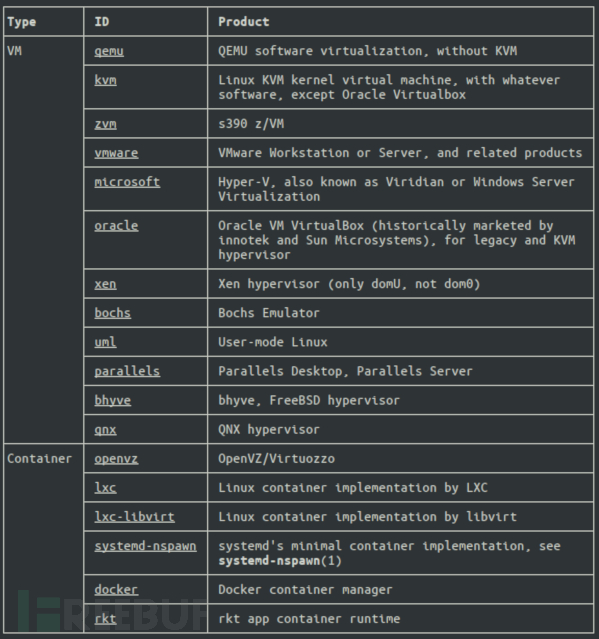
资源获取
1、virt-what:【点我获取】
2、Bash for循环:【参考文档】
3、yum命令:【参考文档】
4、apt命令:【参考文档】
5、apt-get命令:【参考文档】
* 参考来源:cyberciti,FB小编Alpha_h4ck编译,转载请注明来自FreeBuf.COM
如需授权、对文章有疑问或需删除稿件,请联系 FreeBuf 客服小蜜蜂(微信:freebee1024)










